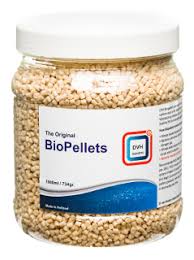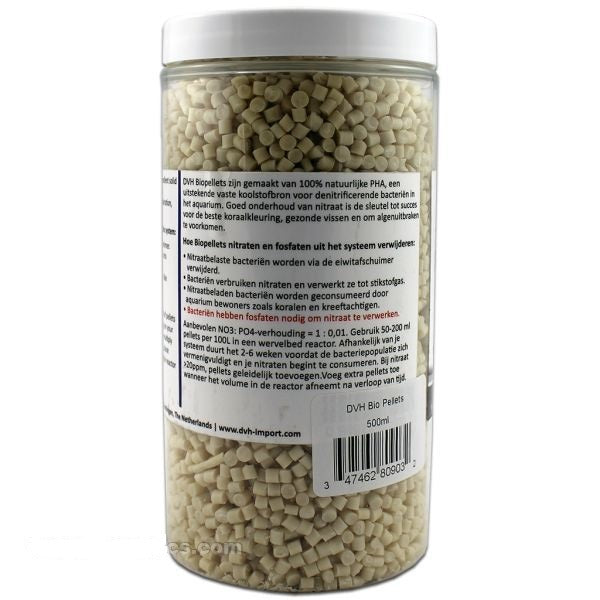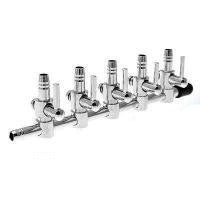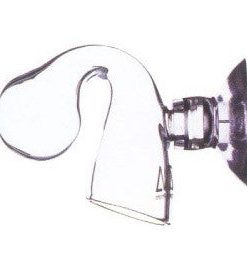DvH Aquatics NP-reducing BioPellets NP
$ 65,00 $ 32,50
The positive effects of NP-reducing BioPellets on water quality are based on the principle of immobilization. Waste products from the water, mainly nitrate and phosphate, are converted into bacteria. This keeps the aquarium water clean.
NP-reducing BioPellets are composed of biologically degradable polymers that can be placed in a fluidized filter or filter canister. The pellets will allow aerobic growth of bacteria which consequently will consume nitrate and phosphate simultaneously. The bacteria will use up the carbon from the BioPellets, whilst nitrogen and phosphorus are taken from the water as nitrate and (ortho)phosphate. This conversion of organic BioPellets (together with inorganic nitrogen and phosphorus) into microbial biomass is called immobilization. In addition, anaerobic layers will develop, resulting in additional denitrification.
The surplus of bacteria will be consumed by filter and suspension feeding organisms such as sponges and corals, or skimmed off by a protein skimmer. On average this “solid wodka method” takes 2-4 weeks to give rise to sufficient bacteria to allow nitrate and phosphate levels to drop. The main advantage of this method over using Wodka or sugar as a carbon source is that NP-reducing BioPellets stimulate local growth of bacteria in a filter compartment, instead of all over in the aquarium where they may clog up pipes and hoses. They also prevent the growth of cyanobacteria, as the bacteria growing on NP-reducing BioPellets will compete with these phototrophic nuisance microbes. Finally, NP-reducing BioPellets will save the aquarist a lot of time, as no daily dosages of carbon are required.
Product guidelines
NP-reducing Biopellets can be placed in canister filters or fluidized reactors. The latter configuration may yield better results, and prevents detritus buildup. A proper starting dosage is 0.5-1 liter of pellets per 500 liters of system volume (12,5-25 fl. oz. for every 100 USG). After about 2-4 weeks, nitrate and phosphate levels should start decreasing. For some aquaria experiencing heavy feeding, higher dosages are appropriate. Examples are aquaria which house large quantities of azooxanthellate corals, sponges, tunicates or large schools of Anthias fish. Dosages may be increased indefinitely, provided the aquarium water is sufficiently aerated.
NP-reducing BioPellets are consumed by bacteria, which is why new pellets need to be added every 3-6 months to compensate for digested substrate. This can be seen during inspection of the filter. These figures however depend on aquarium conditions and are strongly influenced by feeding regimes and livestock. Taking regular measurements of both nitrate and phosphate levels in the aquarium is recommended, after which dosages may be increased or decreased.
We also suggest placing the outlet of the pellet filter in front of a protein skimmer, to limit the amount of bacteria entering the system. This has the additional benefit of increased gas exchange (CO2-removal and O2-addition). The pellets should never be used without sufficient aeration, as this may lead to low oxygen and pH levels, especially during night time. Proper aeration can be established with air pumps and protein skimmers.
When heavy feeding is required, it is recommended to combine the pellets with standard phosphate adsorbents. The reason for this is that most aquarium feeds contain higher levels of phosphate than is consumed by bacteria, fish and invertebrates, when compared to nitrogen. Some phosphate adsorbents however deplete alkalinity and may reduce pH. Using phosphate adsorbent media based on iron hydroxide does not have this disadvantage.
Important:
• Maintain sufficient water flow through the BioPellets, to prevent production of hydrogen sulphide gas.
• The use of ozone and UV will negatively affect bacterial recruitment of the BioPellets and increase the maturation time of the filter. Adding bacterial cultures may alleviate this problem and shorten filter maturation time in general.
• When nitrate and phosphate are already very low before applying BioPellets, a decrease in these levels may not be detectable with standard aquarium testkits.
| Size | 500ml, 1000ml |
|---|
Fast Shipping and Professional Packaging
We can offer a variety of shipping options thanks to our long-term relationship with UPS FedEx DHL. Our warehouse staff will package all goods to our exacting requirements. Prior to shipping, your goods will be thoroughly examined and securely secured. We deliver to thousands of customers every day from all over the world. This is a sign of our determination to be the largest online retailer in the world. Warehouses and distribution centers are located throughout Europe as well as in the USA.
Note: Orders that contain more than one item will be assigned a separate processing time for each item.
Prior to shipment, we examine the items ordered thoroughly before sending the items. Most orders are shipped within 48 hours. The expected delivery time is 3 to 7 days.
Returns
The stock is constantly changing and cannot be fully controlled by us due to the involvement of many different parties, such as the factory and our warehouse. The levels of stock can change at any moment. You may not receive your order once the order has been made.
The policy is 30 days. If it's been longer than 30 days since you made your purchase and we're unable to offer you a complete exchange or refund.
To be eligible for a return your item must be unused and in the same condition as you received it. You must have the item in its original packaging.
Related products
Conditioner
Maintenance Tools
RO/DI
Air Pump Accessories
Filter Media
Plant Fertilisation
Freshwater Plant
Air Pump Accessories
Plant Fertilisation
Plant Fertilisation
Bacteria
Filter Media
Plant Fertilisation
CO2 Accessories
Air Pump Accessories
Substrate








































